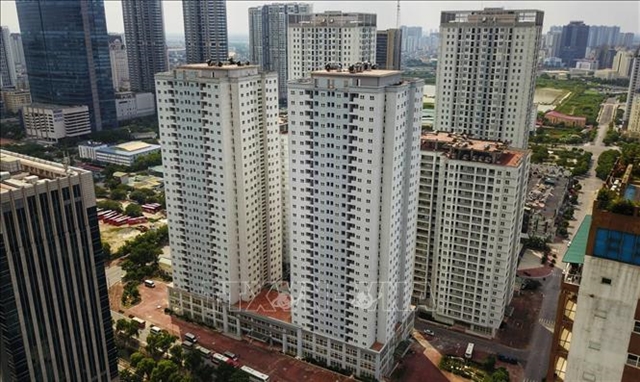 Society
Society


|
| A part of the Nam Trung Yên urban area in Hà Nội's Cầu Giấy District. VNA/VNS Photo |
HÀ NỘI — Thousands of resettlement houses worth thousands of billions đồng in HCM City and Hà Nội have been abandoned for many years, causing waste to the State budget.
According to the Hà Nội Department of Construction, there are nearly 18,000 resettlement apartments in the city, most of which were already paid for by homeowners or allocated for resettlement projects, with the remaining 400 uninhabited.
However, Tuổi Trẻ (Youth) newspaper reported that Hà Nội has thousands of resettlement apartments that are still abandoned. Hundreds of apartments have been completed but have not yet been accepted for wastewater treatment and fire prevention and control systems.
Most of these resettlement areas are degraded and lack accompanying utilities such as entertainment areas and parks.
Four buildings at the intersection of Trần Thái Tông-Duy Tân street in Dịch Vọng Hậu Ward, Cầu Giấy District, have been left empty for more than ten years and are surrounded by fields of grass.
Lê Văn Bích, a local resident, said these buildings have been vacant and sometimes become a place for rubbish tipping.
Similarly, three buildings with 150 apartments in Sài Đồng new urban area in Long Biên District's Phúc Đồng Ward are still uninhabited, despite being built years ago.
The back of these buildings is being used to grow vegetables by people, while many parts of the buildings are showing signs of serious deterioration.
"We cleared all the grass to grow vegetables. We hope the city will soon put it into use so we don't have to watch out for strangers who often gather here at night," Nguyễn Thị Hằng, a local resident said.
In Hoàng Mai District, some resettlement buildings have been also abandoned for years.
A representative of the Hà Nội Department of Construction said the resettlement apartments have not been inhabited due to the complaints from homeowners.
Many people want to receive support in cash instead of apartments.
"We will try to put the buildings into use soon and handle violations in land use for improper purposes and withdraw the unclaimed apartments for other projects," the department's representative said.
Similarly, in HCM City, there are also thousands of resettlement apartments vacant.
Many blocks in the Vĩnh Lộc B resettlement area, Bình Chánh District, have been completed but remain empty, surrounded by grass and degraded by the weather.
According to a report by the HCM City Department of Construction, the city has 11,681 resettlement apartments.
Of this, 4,000 have been allocated to districts to use resettlement.
Over 2,500 are used as backup plans and the remaining are still in the process of being auctioned.
Phạm Đăng Hồ, head of the Housing and Real Estate Market Office, said the number of resettlement apartments waiting for auction is mostly located in suburban areas and they are not meet the requirement of residents.
Meanwhile, the problems in the auction remain unresolved.
In May, the Ministry of Construction sent a document to the People's Committees of provinces and cities to request localities report and propose solutions on the use and management of resettlement housing projects.
Talking about building a housing fund for resettlement in the future, Hồ said in the near future, the State needs to invest in building all kinds of social housing to support people.
Residents can also receive financial compensation instead of a resettlement apartment if they opt for that option.
The State will limit the spending budget for resettlement projects separately and will buy land from investors if the land fund runs out, he said.
Resettlement houses must meet people's requirements and ensure that the affected people have a decent living place with equal or better conditions than their old places, said Dr Đào Ngọc Nghiêm, deputy head of the Việt Nam Urban Development Planning Association.
Resettlement areas need technical infrastructure, especially public infrastructure around the buildings, he said.
Nghiêm said it is necessary to build open mechanisms so that abandoned apartments can be rented in the short term, creating revenue for the State budget.
He added that site clearance should be conducted together with building resettlement areas, to avoid early completion of resettlement houses, which leads to their desertion.
In building resettlement projects, both the State and investors have not surveyed the opinions and needs of the people whose land has been acquired. Residents are only informed about the proposed resettlement plan, according to Dr Nguyễn Thị Anh from the University of Economics HCM City.
Therefore, a sociological investigation is needed to know people's aspirations, and make the resettlement policy more appropriate, Anh said. — VNS




